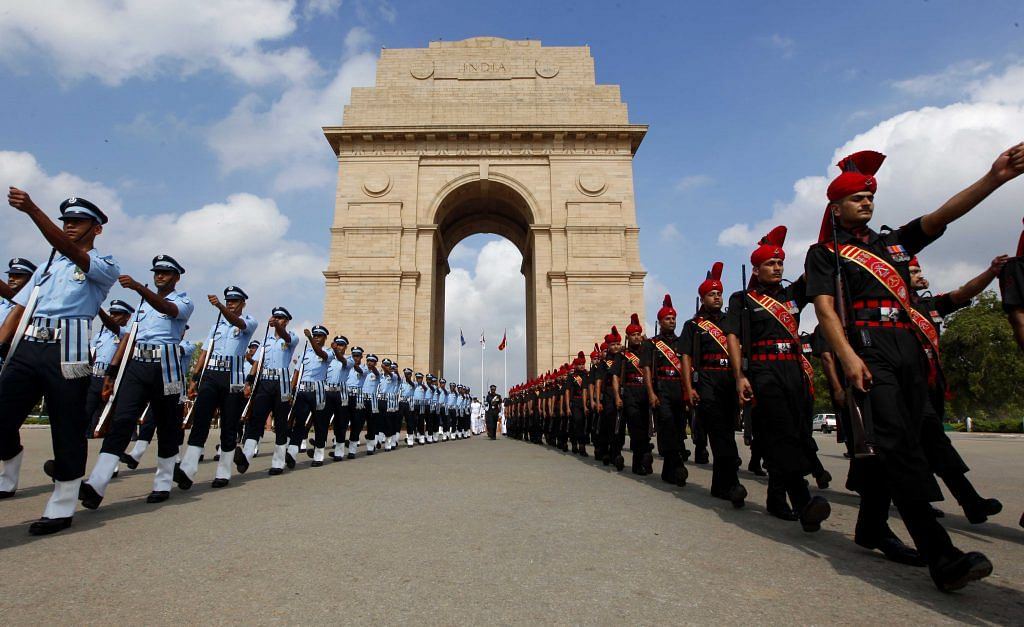Cross-service cooperation in the Indian armed forces is still largely symbolic.
We must celebrate the 19th anniversary of the Kargil War and the tactical valour displayed by Indian soldiers and unit-level leaders in retaking Kargil heights. But we must also rue the slow progress we have made towards ‘jointness’ or cross-service cooperation in the armed forces.
With excellent intentions, we set up a tri-services joint academy (the National Defence Academy) very soon after Independence, a joint staff college (the Defence Services Staff College), the National Defence College, and a college of defence management. Apart from these, there are several joint courses and capsules of smaller durations. Yet, while no major nation has as much joint training and professional military education inputs as India, we have fallen short of delivering jointness in terms of outcome.
One often hears many inputs and suggestions like greater similarity in uniforms, cross-billeting and even more joint education. But these are largely symbolic. There is a reluctance to see jointness as critical to warfighting effectiveness, which in turn, ought to feed into deterrence as well as give higher assurance of victory. In the process of joint training, we have perhaps diluted the importance of single-service professional competence and the benefits of single-service cultures in warfighting. Despite an overwhelming predominance of NDA graduates at the levels of service chiefs and commanders-in-chief since the 1990s (often due to an age advantage over other types of entries), why is it that attitudes towards true—not symbolic—jointness fall short?
Here are some of the misconceptions about jointness and how we can address them.
Like in the US, military reforms have to be ‘top-down’ from the political masters
Even if we consider the model of the American Goldwater-Nichols Act (GNA) of 1986 signed by President Ronald Reagan, the idea of jointness in the US has a long, fractious and sometimes even vicious history beginning with the 1903 Army and Navy Board. The mid-1941 recommendation by the US Navy General Board for a single chief of staff became the genesis of the Joint Chiefs of Staff (JCS)—a body of senior officers who would advise the President and security council— just weeks after Pearl Harbour. Here, we must merely note that but for the honest, hard-hitting testimony in February 1982 by US Air Force general and chief of the JCS at the time David C. Jones, the GNA may not have happened at all or much later:
“It is not sufficient to have resources, dollars, and weapon systems; we must also have an organisation which allows us to develop the proper strategy, necessary planning and the full warfighting capability. We do not have an adequate organisational structure today.”
The trigger for reforms has to be generated by those in uniform.
Something like the GNA is required to bestow the chief of defence services ‘real power’
The GNA’s main purpose was not to make the position of the Chairman of the Joint Chiefs of Staff (CJCS) more powerful but to reinvigorate civilian supremacy and improve the quality of military advice. The first sentence of the GNA says:
“An Act to reorganise the Department of Defense (DOD) and strengthen civilian authority in the DOD, to improve military advice to the President, NSC, secretary of defense, to place clear responsibility on the commanders of the unified and specified combatant commands to accomplish the specified missions…”
The GNA legislated better integration between the political power centres and the Pentagon, and also improved the theatres of war with periodic policy guidance and strategic directives. The CJCS always had adequate authority and power but much depended on his personality, the interaction between him and his military colleagues, political masters in the government as well as the Senate. The GNA ironed out some infirmities even as some new ones appeared from time to time.
We need a ‘single-point’ military adviser
This oft-heard statement is flawed. The CJCS is unambiguously designated the ‘principal military adviser’ to the President, the National Security Council and the secretary of defence. Yes, the CJCS would certainly be the individual most consulted by the defence secretary or in our case, by the political leadership. But in no country, whether a democracy or an authoritarian regime, would ‘single-point’ advice be necessarily acceptable or advisable. The GNA, in fact, clearly lays down the process to be followed in case any member has a different opinion or advice to give.
The service chiefs are very important as heads of their service as well as members of a committee; consensus among them is a good thing, dissent sometimes necessary and yesmanship is always risky.
Integrated theatre commands (ITCs) are ‘not valid in our context’
Each country will have to develop models for jointness that are likely to better suit its need for favourable war-fighting outcomes. Joint theatres were made by the Russia (and erstwhile USSR) along its territorial expanse, like in China. At this stage, they do not have theatres on a global canvas like the US. So, in our own contiguous geo-strategic environment and ‘island chains’ much thinking has gone into creating ITCs. I would prefer to call them joint theatre commands (JTC) and would want that the integration of command and control be centred in Delhi with a reconfigured integrated defence staff headquarters and single service HQs.
Arguments have been made, especially by Air Force personnel—serving and veterans—that we need not have such commands just because others have them. A counter is that we would do well to have joint commands even if no one else were to have them.
There never will be a rosily perfect time for these changes, but it is never too late or too early for jointness at the outcomes end.
The author is Rear Admiral Sudarshan Shrikhande, AVSM, IN (Retd).
